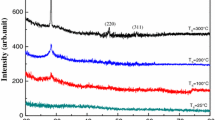Abstract
A simple model to describe the fundamental absorption of amorphous hydrogenated silicon carbide thin films based on band fluctuations is presented. It provides a general equation describing both the Urbach and Tauc regions in the absorption spectrum. In principle, our model is applicable to any amorphous material and it allows the determination of the bandgap. Here we focus on the bandgap engineering of amorphous hydrogenated silicon carbide layers. Emphasis is given on the role of hydrogen dilution during the deposition process and post deposition annealing treatments. Using the conventional Urbach and Tauc equations, it was found that an increase/decrease of the Urbach energy produces a shrink/enhancement of the Tauc-gap. On the contrary, the here proposed model provides a bandgap energy which behaves independently of the Urbach energy.
Similar content being viewed by others
References
F. Liu et al, J. Micromech. Microeng. 20, 035011 (2010).
M. A. Fraga et al, J. Mater. Sci. Mater. Electron. 19, 835 (2007).
B. N. Pushpakaran et al, Renew. Sust. Energ. Rev. 55, 971 (2016).
F. Zhu et al, Philos. Mag. 89, 2723 (2009).
G. R. Fisher and P. Barnes, Philos. Mag. Part B. 61, 217 (1990).
F. Zhu et al, Philos. Mag. 89, 2723 (2009).
J. A. Guerra et al, J. Phys. D: Appl. Phys. 49, 195102 (2016).
H. S. Medeiros et al, Surf. Coat. Technol. 206, 1787 (2011).
L. R. Tessler and I. Solomon, Phys. Rev. B 52, 10962 (1995).
J. Tauc, Res. Bull. 3, 37 (1968).
F. Urbach, Phys. Rev. 92, 1324 (1953).
D. J. Dunstan, J. Phys. C: Solid State Phys. 16, L567 (1983).
S. K. O’Leary and S. Zukotynski, Phys. Rev. B 52, 7795 (1995).
M. Bickermann et al, Mater. Sci. Forum 49, 353 (2001)
R. Swanepoel, J. Phys. E: Sci. Instrum. 16, 1214 (1983).
S. K. O’Leary and S. Zukotynski, Phys. Rev. B 51, 4143 (1995).
Author information
Authors and Affiliations
Rights and permissions
About this article
Cite this article
Guerra, J.A., Montañez, L.M., Tucto, K. et al. Bandgap Engineering of Amorphous Hydrogenated Silicon Carbide. MRS Advances 1, 2929–2934 (2016). https://doi.org/10.1557/adv.2016.422
Published:
Issue Date:
DOI: https://doi.org/10.1557/adv.2016.422



